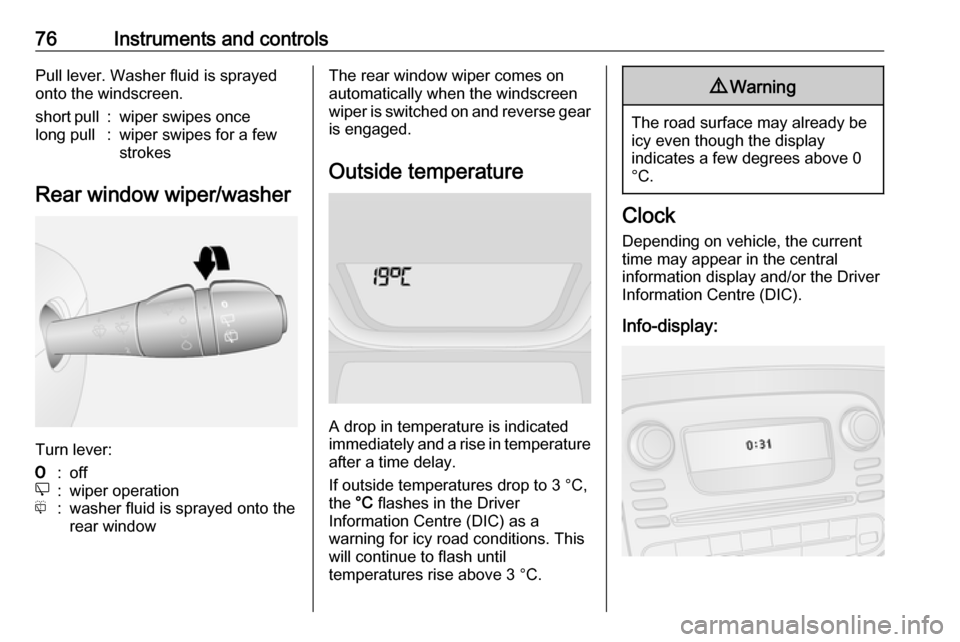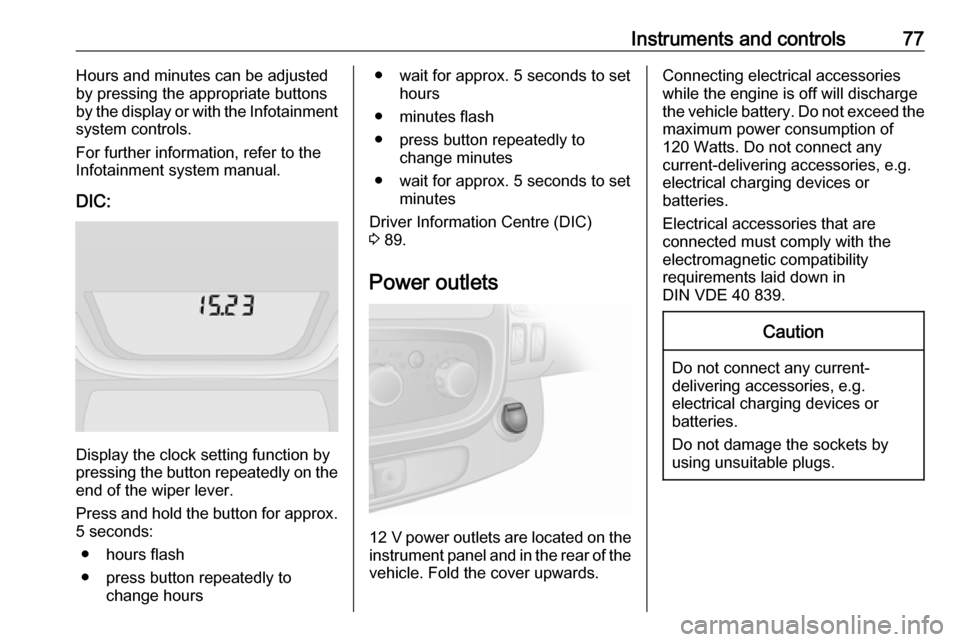VAUXHALL VIVARO 2016 Manual PDF
Manufacturer: VAUXHALL, Model Year: 2016, Model line: VIVARO, Model: VAUXHALL VIVARO 2016Pages: 209, PDF Size: 4.86 MB
Page 71 of 209

Storage69
The rear parcel shelf can be installed
in 2 positions, i.e. the upper position
or the lower position.
The rear parcel shelf may also be
folded up, allowing for greater
flexibility in the load compartment.
Removing
To remove, release parcel shelf from
its retainers on both sides.
If the rear seats 3 45 are in the folded
position, remove the parcel shelf and
store it horizontally in front of the
folded rear seats.
Installing
Refit the parcel shelf by engaging in
the retainers on both sides.
Lashing eyes
Lashing eyes are mounted in the load
compartment to enable cargo to be secured against slippage using
lashing straps or a luggage floor net.
Lashing eyes may be located on the
vehicle floor and/or in the sidewall.
The number and location of the
lashing eyes may vary depending on
the vehicle.
The maximum force applied to the
lashing eyes should not exceed
6250 N at 30°.
Safety net The safety net can be installed behind
the front seats or the rear seats.
Passengers must not be transported
behind the safety net.
Page 72 of 209

70StorageInstalling
Release the covers in the roof lining
(using a flat blade screwdriver) to
access the mountings, then insert the
load compartment net rods into the
left and right mounting locations and secure.
Attach the straps to the lashing eyes
or rings behind the seats, then
tension the straps.
Removal Release tension from straps and
unhook straps from lashing eyes or
rings. Remove net rods from their
mounting locations and close the
covers.
Warning triangle
The warning triangle can be
accommodated in the space under
the seats.
Underseat storage 3 67.
First aid kit
The first aid kit can be accommodated
in the space under the seats.
Underseat storage 3 67.
Page 73 of 209

Storage71Roof rack system
Roof rack For safety reasons and to avoiddamage to the roof, the vehicle
approved roof rack system is
recommended. For further
information, contact your workshop.
Follow the installation instructions
and remove the roof rack when not in
use.
Notice
If tyres of size 215/60 R17 C are
fitted, consult a workshop before
installing a roof rack.
Refer to "Loading information" below
for further information.Loading information
● Heavy objects in the load compartment should be evenly
distributed and placed as far
forward as possible. If objects
can be stacked, the heavier
objects should be placed at the
bottom.
● Secure objects with lashing straps attached to lashing eyes
3 69.
● Secure loose objects in load compartment to prevent sliding.
● When transporting objects in the load compartment, the backrests
of the rear seats must not be
angled forward.
● Do not allow the load to protrude above the upper edge of the
backrests.
● Do not place any objects on the instrument panel.
● The load must not obstruct the operation of the pedals, parking
brake and gear selector, orhinder the freedom of movement
of the driver. Do not place any
unsecured objects in the interior.
● Do not drive with an open load compartment. In addition, the
number plate is only
distinguishable and illuminated
correctly if the doors are closed.9 Warning
Always make sure that the load in
the vehicle is securely stowed.
Otherwise objects can be thrown
around inside the vehicle and
cause personal injury or damage
to the load or car.
● The payload is the difference between the permitted gross
vehicle weight (see identification
plate 3 184) and the EC kerb
weight.
To calculate the payload, enter
the data for your vehicle in the
Weights table at the front of this
manual.
The EC kerb weight includes
weights for the driver (68 kg),
Page 74 of 209

72Storageluggage (7 kg) and all fluids (tank
90% full).
Optional equipment and
accessories increase the kerb
weight.
● Driving with a roof load increases
the sensitivity of the vehicle to
cross-winds and has a
detrimental effect on vehicle
handling due to the vehicle's
higher centre of gravity.
Distribute the load evenly and secure it properly with retaining
straps. Adjust the tyre pressure
and vehicle speed according to
the load conditions. Check and
retighten the straps frequently.
Do not drive faster than 75 mph.
The permissible roof load is
200 kg for H1 Roof height
variants and 150 kg for H2 Roof
height variants (excludes
Platform cab conversions). The
roof load is the combined weight
of the roof rack and the load.
Page 75 of 209

Instruments and controls73Instruments and
controlsControls ....................................... 74
Steering wheel adjustment ........74
Steering wheel controls .............74
Horn ........................................... 74
Steering column controls ...........74
Windscreen wiper/washer .........75
Rear window wiper/washer .......76
Outside temperature ..................76
Clock ......................................... 76
Power outlets ............................. 77
Cigarette lighter ......................... 78
Ashtrays .................................... 78
Warning lights, gauges and indi‐ cators ........................................... 78
Instrument cluster ......................78
Speedometer ............................. 78
Odometer .................................. 79
Trip odometer ............................ 79
Tachometer ............................... 79
Fuel gauge ................................ 80
Fuel economy gauge .................80
Service display .......................... 80
Control indicators ......................81
Turn signal ................................. 83Seat belt reminder.....................84
Airbag and belt tensioners .........84
Airbag deactivation ....................84
Charging system .......................84
Malfunction indicator light ..........85
Service vehicle soon .................85
Stop engine ............................... 85
Brake system ............................. 85
Antilock brake system (ABS) .....86
Upshift ....................................... 86
Electronic Stability Program ......86
Electronic Stability Program off ............................................. 86
Engine coolant temperature ......86
Preheating ................................. 87
AdBlue ....................................... 87
Tyre pressure monitoring system ...................................... 87
Engine oil pressure ....................87
Fuel economy mode ..................88
Low fuel ..................................... 88
Autostop .................................... 88
Exterior light .............................. 88
High beam ................................. 88
Fog light ..................................... 88
Rear fog light ............................. 88
Cruise control ............................ 88
Tachograph ............................... 89
Door open .................................. 89Information displays.....................89
Driver Information Centre ..........89
Vehicle messages ........................90
Warning chimes .........................90
Engine oil level .......................... 91
Trip computer ............................... 91
Tachograph .................................. 93
Page 76 of 209

74Instruments and controlsControlsSteering wheel adjustment
Unlock lever, adjust steering wheel,
then engage lever and ensure it is
fully locked.
Do not adjust steering wheel unless
vehicle is stationary and steering
wheel lock has been released.
Steering wheel controls
The cruise control and speed limiter
can be operated via the controls on
the steering wheel.
Cruise control and speed limiter
3 131.
Horn
Press j.
The horn will sound regardless of
ignition switch position.
Steering column controls The Infotainment system and a
connected mobile phone can be
operated via the controls on the
steering column.
Further information is available in the
Infotainment system manual.
Page 77 of 209

Instruments and controls75Windscreen wiper/washerWindscreen wiper7:offAUTO or K:interval wiping or
automatic wiping with
rain sensor1:slow2:fast
Do not use if the windscreen is frozen.
Switch off in car washes.
Adjustable wiper interval
Wiper lever in position AUTO or P.
Turn the adjuster wheel to adjust the
desired wipe interval:
short interval:turn adjuster
wheel upwardslong interval:turn adjuster
wheel downwards
Automatic wiping with rain sensor
Wiper lever in position AUTO or P.
The rain sensor detects the amount of water on the windscreen and
automatically regulates the frequency
of the windscreen wiper.
Automatic wiping will need to be
reselected whenever the ignition has
been switched off.
Adjustable sensitivity of the rain
sensor
Turn the adjuster wheel to adjust the
sensitivity:low sensitivity:turn adjuster
wheel upwardshigh sensitivity:turn adjuster
wheel downwards
The rain sensor is located on the
windscreen. Keep the sensor free
from dust, dirt and ice.
Windscreen washer
Page 78 of 209

76Instruments and controlsPull lever. Washer fluid is sprayed
onto the windscreen.short pull:wiper swipes oncelong pull:wiper swipes for a few
strokes
Rear window wiper/washer
Turn lever:
7:offe:wiper operationf:washer fluid is sprayed onto the
rear windowThe rear window wiper comes on
automatically when the windscreen
wiper is switched on and reverse gear
is engaged.
Outside temperature
A drop in temperature is indicated
immediately and a rise in temperature
after a time delay.
If outside temperatures drop to 3 °C, the °C flashes in the Driver
Information Centre (DIC) as a
warning for icy road conditions. This
will continue to flash until
temperatures rise above 3 °C.
9 Warning
The road surface may already be
icy even though the display
indicates a few degrees above 0
°C.
Clock
Depending on vehicle, the current
time may appear in the central
information display and/or the Driver
Information Centre (DIC).
Info-display:
Page 79 of 209

Instruments and controls77Hours and minutes can be adjusted
by pressing the appropriate buttons
by the display or with the Infotainment
system controls.
For further information, refer to the
Infotainment system manual.
DIC:
Display the clock setting function by
pressing the button repeatedly on the end of the wiper lever.
Press and hold the button for approx.
5 seconds:
● hours flash
● press button repeatedly to change hours
● wait for approx. 5 seconds to set hours
● minutes flash
● press button repeatedly to change minutes
● wait for approx. 5 seconds to set minutes
Driver Information Centre (DIC)
3 89.
Power outlets
12 V power outlets are located on the
instrument panel and in the rear of the vehicle. Fold the cover upwards.
Connecting electrical accessorieswhile the engine is off will discharge
the vehicle battery. Do not exceed the
maximum power consumption of
120 Watts. Do not connect any
current-delivering accessories, e.g.
electrical charging devices or
batteries.
Electrical accessories that are
connected must comply with the
electromagnetic compatibility
requirements laid down in
DIN VDE 40 839.Caution
Do not connect any current- delivering accessories, e.g.
electrical charging devices or
batteries.
Do not damage the sockets by
using unsuitable plugs.
Page 80 of 209

78Instruments and controlsCigarette lighter
The cigarette lighter is located on theinstrument panel.
Press in cigarette lighter. It switches
off automatically once the element is
glowing. Pull out lighter.
Ashtrays
Caution
To be used only for ash and not for combustible rubbish.
Portable ashtray
Ashtray container for mobile use in
the vehicle. To use, open cover.
Ashtrays can be placed in the
cupholders at both ends of the
instrument panel, centrally in the
lower instrument panel and in the rear
seat area.
Cupholders 3 66.
Warning lights, gauges
and indicators
Instrument cluster
In some versions, the needles of the
instruments briefly rotate to the end
position when the ignition is switched on.
Speedometer
Indicates vehicle speed.